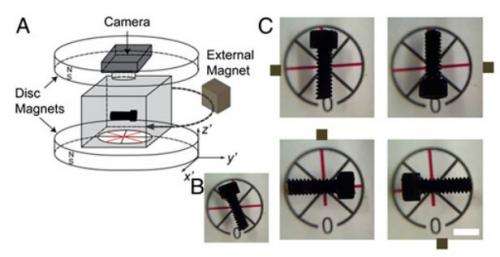August 26, 2014 report
Researchers devise several ways to orient nonmagnetic objects in 3D space using magnetic levitation

(Phys.org) —A team of researchers at Harvard University has come up with a way to move objects in three-dimensional space without touching them. As they describe in their paper published in Proceedings of the National Academy of Sciences, the technique involves suspending an object in a paramagnetic (very weakly attracted) liquid and then using magnets to manipulate the liquid to hold the object in place—levitating it.
Using magnets to cause a magnetic object to move in 3D space has been done before—known as MagLev, it's the technology behind MagLev trains—the reduced friction is more efficient. In this new effort the researchers sought to pull off the same trick with objects that are not necessarily magnetic, such as a plastic screw. To make that happen, they outfitted a tank with magnets on the top and sides then poured in a paramagnetic clear liquid—the magnets exerted influence on the liquid allowing it to be manipulated. The researchers then dropped in an object, such as a plastic screw and caused it to levitate in the center of the tank by manipulating the liquid using the magnets. This arrangement allowed the screw to be held in place inside the tank and moved in 3D space as the tank itself was moved around—left to right, up and down, rotated upside down, etc.
Using a similar setup, the researchers found that the orientation of an object they caused to levitate in their tank depended on the geometry of both the object and the magnets used. They found that objects with a range of sizes, shapes, and materials could be moved around in 3D space without contact (save for the liquid solution). They also found that they could exert other types of influence on the suspended object by moving a magnet around inside the tank thereby manipulating the liquid that was close to the object.
Using MagLev to manipulate objects could have applications ranging from soft-robotics to biometrics and of course as part of a production process that could benefit from construction without the need for touching such as the manipulation of hydrogels, elastomers and jammed granular media.
More information: Noncontact orientation of objects in three-dimensional space using magnetic levitation, Anand Bala Subramaniam, PNAS, DOI: 10.1073/pnas.1408705111
Abstract
This paper describes several noncontact methods of orienting objects in 3D space using Magnetic Levitation (MagLev). The methods use two permanent magnets arranged coaxially with like poles facing and a container containing a paramagnetic liquid in which the objects are suspended. Absent external forcing, objects levitating in the device adopt predictable static orientations; the orientation depends on the shape and distribution of mass within the objects. The orientation of objects of uniform density in the MagLev device shows a sharp geometry-dependent transition: an analytical theory rationalizes this transition and predicts the orientation of objects in the MagLev device. Manipulation of the orientation of the levitating objects in space is achieved in two ways: (i) by rotating and/or translating the MagLev device while the objects are suspended in the paramagnetic solution between the magnets; (ii) by moving a small external magnet close to the levitating objects while keeping the device stationary. Unlike mechanical agitation or robotic selection, orienting using MagLev is possible for objects having a range of different physical characteristics (e.g., different shapes, sizes, and mechanical properties from hard polymers to gels and fluids). MagLev thus has the potential to be useful for sorting and positioning components in 3D space, orienting objects for assembly, constructing noncontact devices, and assembling objects composed of soft materials such as hydrogels, elastomers, and jammed granular media.
Journal information: Proceedings of the National Academy of Sciences
© 2014 Tech Xplore



















